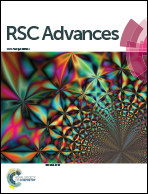In situ growth of metallic 1T-WS2 nanoislands on single-walled carbon nanotube films for improved electrochemical performance†
Abstract
Layered tungsten disulfide (WS2) is a potential electrode material for electric double layer capacitance (EDLC) and hydrogen evolution reaction (HER). However, the electrochemical performance of WS2 has been hindered by the semiconducting nature and poor active sites. Herein, we have demonstrated a bottom-up hydrothermal approach to fabricate metallic 1T-WS2 nanoislands in situ grown on flexible single-walled carbon nanotube nonwovens (1T-WS2@SWCNT). The robust hybrids with a tight interface possess nanoscopic few-layered WS2 pieces with an abundance of exposed sites, along with a unique woven-architecture originating from the high conductive carbon nanotube network. The in situ-growing enhanced interface between metallic WS2 nanoislands and SWCNTs provides a relatively strong electrical coupling integrity, which facilitates charge transfer during electrochemical reactions. The merits of rich active sites, excellent conductivity and well bonding-interactions are significantly beneficial to improve the electrochemical performance. Particularly, in contrast to the pure material, the as-obtained hybrids are found to exhibit higher EDLC capacity (226 mF cm−2), almost 646-fold higher than pure 1T-WS2, smaller Tafel slope (57 mV per decade) and lower HER overpotential (∼25 mV) than any WS2-based materials reported so far.



 Please wait while we load your content...
Please wait while we load your content...